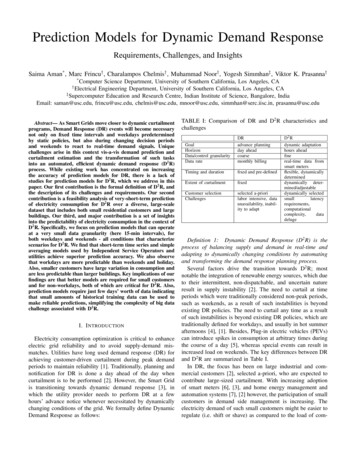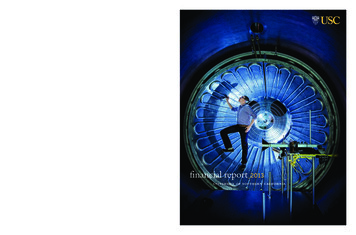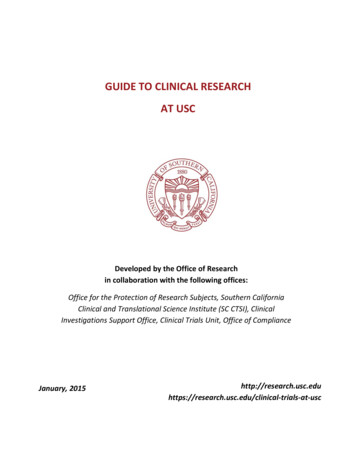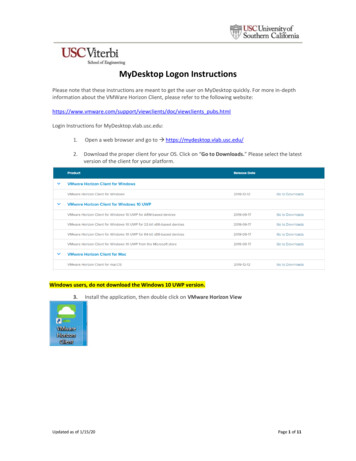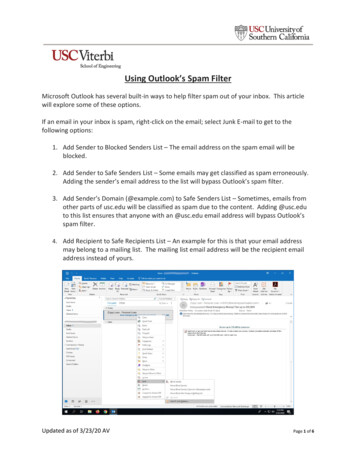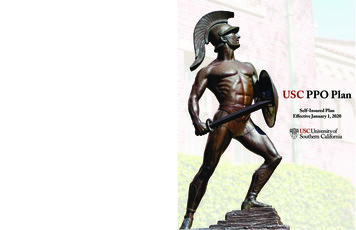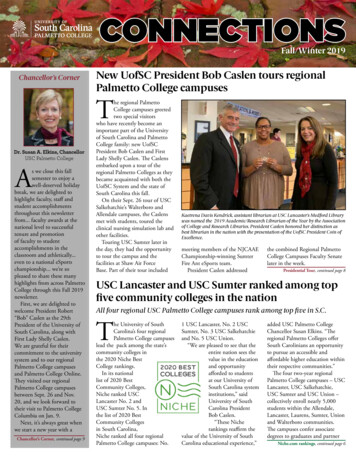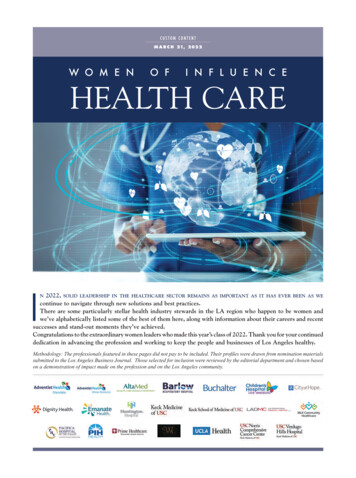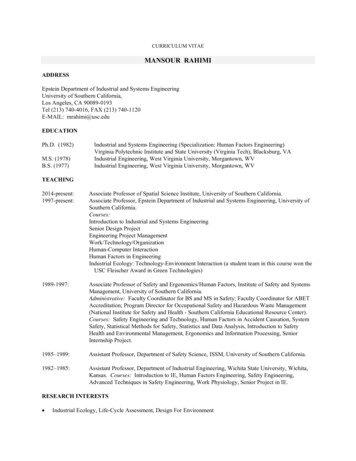
Transcription
CURRICULUM VITAEMANSOUR RAHIMIADDRESSEpstein Department of Industrial and Systems EngineeringUniversity of Southern California,Los Angeles, CA 90089-0193Tel (213) 740-4016, FAX (213) 740-1120E-MAIL: mrahimi@usc.eduEDUCATIONPh.D. (1982)M.S. (1978)B.S. (1977)Industrial and Systems Engineering (Specialization: Human Factors Engineering)Virginia Polytechnic Institute and State University (Virginia Tech), Blacksburg, VAIndustrial Engineering, West Virginia University, Morgantown, WVIndustrial Engineering, West Virginia University, Morgantown, WVTEACHING2014-present:1997-present:Associate Professor of Spatial Science Institute, University of Southern California.Associate Professor, Epstein Department of Industrial and Systems Engineering, University ofSouthern California.Courses:Introduction to Industrial and Systems EngineeringSenior Design ProjectEngineering Project er InteractionHuman Factors in EngineeringIndustrial Ecology: Technology-Environment Interaction (a student team in this course won theUSC Fleischer Award in Green Technologies)1989-1997:Associate Professor of Safety and Ergonomics/Human Factors, Institute of Safety and SystemsManagement, University of Southern California.Administrative: Faculty Coordinator for BS and MS in Safety; Faculty Coordinator for ABETAccreditation; Program Director for Occupational Safety and Hazardous Waste Management(National Institute for Safety and Health - Southern California Educational Resource Center).Courses: Safety Engineering and Technology, Human Factors in Accident Causation, SystemSafety, Statistical Methods for Safety, Statistics and Data Analysis, Introduction to SafetyHealth and Environmental Management, Ergonomics and Information Processing, SeniorInternship Project.1985–1989:Assistant Professor, Department of Safety Science, ISSM, University of Southern California.1982–1985:Assistant Professor, Department of Industrial Engineering, Wichita State University, Wichita,Kansas. Courses: Introduction to IE, Human Factors Engineering, Safety Engineering,Advanced Techniques in Safety Engineering, Work Physiology, Senior Project in IE.RESEARCH INTERESTS Industrial Ecology, Life-Cycle Assessment, Design For Environment
Curriculum Vitae for M. Rahimi Environment/Safety/Human FactorsHuman-Computer InteractionResearch Projects2015: Senior Investigator (PIs: Massoud Pedram and Sandeep Gupta)“SHF: Small: Technology Development and Design Optimization of Hybrid Electrical Energy Storage Systems”Budget: 449,997 (Rahimi’s share: 0.5 summer month)Project period: 7/1/12 –12/31/152014: Senior Investigator (PIs: Massoud Pedram and Sandeep Gupta)“SHF: Small: Technology Development and Design Optimization of Hybrid Electrical Energy Storage Systems”Budget: 449,997 (Rahimi’s share: 0.5 summer month)Project period: 7/1/12 –12/31/152013: Senior Investigator (PI: Massoud Pedram)“NSF SHF: Small:Variability-Aware System-Level Power Management in Multi-Processor Systems (53-45035580)”National Science Foundation, Software/Hardware FoundationsBudget: 400,000 (Rahimi’s share: one summer month)Date: 09/01/2010 to 08/31/20132012: Faculty Affiliate (PIs: Najmedin Meshkati, Alex Capron)“USC Health Systems Improvement Collaborative”USC Research Collaboration FundBudget: 30,0002012: Faculty Affiliate (PIs: Paul Adler, Jim Haw, Roger Ghanem)“An interdisciplinary faculty colloquium on Environmental Sustainability and the Global Economy”USC Research Collaboration FundBudget: 30,0002009-2010: CoPI (with Ardavan Asef-Vaziri as PI and Dan Middleton as CoPI)“Operational, Safety, Environmental, and Financial (OSEF) Feasibility Analysis of Integrating ExclusiveTruck Roads into SR60 Freight Corridor ”Leonard Transportation Center, CSU San BernardinoBudget: 49,9992009-2010: CoPI (with Joshua Newell as PI)“Moving Containers Efficiently with Less Impact: Dynamic Modeling and Decision-Support Architecturefor Clean Port Technologies”Metropolitan Transportation Research Center, USC/CSULBBudget: 89,3412008-2009: PI (with Robert Vos)“Social Ventures and Urban Sustainability”Provost’s fund for Undergraduate Research Associates Program, USCBudget: 10,0002008-2009: CoI (with R. McConnel, J. Gauderman, J. Wilson, J. Wolch, A. Curtis, M. Bernstein, S. Fruin, M.Pastor)“Impact of Vehicle Pollution on Children’s Health in Southern California: Methods Development for a SpatiallyBased Assessment of Burden of Disease, Economic and Policy Consequences”Zumberge Fund, USC2
Curriculum Vitae for M. RahimiBudget: 50,0002008-2009: PI“A Comparative Study of Environmental Life-Cycle Impacts for Two Construction Technologies: AutomatedContour Crafting versus Manual Concrete Masonry Unit”USC’s Center for Rapid Automated Fabrication TechnologiesBudget: 7,0002006-2007: PI (with Ardavan Asef-Vaziri and Robert Harrison (U. Texas))“Integrating Inland Ports into the Intermodal Goods Movement System for Ports of Los Angeles and Long Beach”Metrans, USC/CSULB/CalTransBudget: 90,0002006-2007: PI (with Robert Vos and Hilary Bradbury-Huang (LAS))“Building USC Research Capacity for Environmental Life-Cycle Assessment of Future Fuels and Energy Systems”Provost’s Future Fuels and Energy Initiative, USCBudget: 25,0002005-2006: CoPI (with N. Meshkati and J. Torabzadeh (CSULB))“Study of the Exposition Light-Rail Safety for Pedestrians and Drivers”Metrans, USC/CSULB/CalTransBudget: 129,0002005: CoPI (with Kenneth Atkins (JPL), I. Maya, and N. Meshkati)“Development of a Practical Lessons Learned Tool for Project Management/Risk Assessment of Future JPLProjects”Jet Propulsion LaboratoryBudget: 25,0002004-2005: PI (with M. Dessouky, M. Sahimi, and R. Vos (LAS))Supplement funding to “Modeling Eco-Industrial Symbiosis: Greening of Regional Industrial Materials Networks”National Science FoundationBudget: 12,1882004: Co-PI (with Isaac Maya and N. Meshkati)“Cultural Influences on the Implementation of the Lessons Learned in Safety and Risk Management Decisions”NASA Center for Program/Project Management Research, University Space Research AssociationBudget: 75,0002003-2004: Co-PI (with Behrokh Khoshnevis )“Construction by Contour Crafting: A New Paradigm in Building Houses”USC Urban Initiative, Public Policy BriefingBudget: 10,0002002-2003: USC Urban Fellow (with R. Vos and B. Yenice-Ay (Post Doc, ISE))“Modeling the Los Angeles Industrial Ecosystem”USC Urban Initiative, Urban Deans’ CouncilBudget: 25,0002002: Co-PI (with Jennifer Wolch)"Sustainability Starts at Home"Southern California Gas Company, Diverse Markets Outreach ProgramBudget: 99,9753
Curriculum Vitae for M. RahimiThis was a contract assigned to the Center for Sustainable Cities, designed to develop and present curricula on urbansustainability in support of energy conservation and efficiency efforts in hard-to-reach markets in Los Angeles.Rahimi’s responsibility was to develop the environmental life-cycle assessment and analysis of gas and electricpower generation and delivery systems.2002-2003: PI (with M. Sahimi, M. Dessouky, R. Vos)“Modeling Eco-Industrial Symbiosis: Greening of Regional Industrial Materials Networks”National Science FoundationBudget: 110,0002001-2002: Co-PI (with T. Banerjee, L. Mitchel and D. Bahl )“Symposium on Sustainable Industrial Development: Energy and Material Exchange Optimization through EcoIndustrial Networks”National Science FoundationBudget: 40,0002001-2002: PI (with M. Dessouky)“A Methodology for Joint Optimization of Service and Life-Cycle Environmental Impact Assessment ofTransportation Systems”Metrans USC/CSULB/CalTransBudget: 49,9992001-2002: Co-PI (with Albert Rizzo, U. Newmann, C. Shahabi, N. Meshkati)“Design, Development and Evaluation of Virtual Environments: An Integrated Research Program to AddressHuman Factors Issues within the ICT Program"Institute for Creative Technologies, USCBudget: 200,0002000-2001: Co-PI (with N. Meshkati and M. Driver (Marshall Business School))“Investigating the Role of Driver Decision Styles in Highway-Rail Crossing Accidents”Metrans USCC/CSULB/CalTransBudget: 88,0622000: Fellow in Industrial Ecology“Application of Information Technology and Real-Time Design for Environment to Intelligent TransportationSystems”AT&T Research FoundationBudget: 25,0001999-2000: Co-PI (with M. Dessouky)“A Task Decomposition Model for Dispatchers in Dynamic Scheduling of Demand Responsive Transit Systems”Metrans USC/CSULB/CalTransBudget: 50,0001999-2000: Research Coordinator“Research Faculty Network in Design For Environment”Grant: Zumberge Fund (through ESPE-SC), USCBudget: 2,0001990-1992: PI“A Survey/Questionnaire of Disabled after Loma Prieta Earthquake”Grant: National Science Foundation, Biological and Critical SystemsBudget: 15,6924
Curriculum Vitae for M. Rahimi1989-1992: PI"Earthquake Hazards and the Disabled"Grant: National Science Foundation, Biological and Critical SystemsBudget: 131,5241988-1989: PI"Methodological Assessment of Human Reliability in Robot Programming Tasks"Grant: Faculty Research and Innovation Fund, University of Southern CaliforniaBudget: 4,0001988-1989: Co-PIPrincipal Investigator: Waldemar Karwowski (University of Louisville)"Worker Perception of Hazardous Robotics Workstations"Grant: National Institute for Occupational Safety and HealthBudget: 26,5391988-1989: Co-PIPrincipal Investigator: Harry Hurt (ISSM)"Motorcycle Conspicuity and Accidents"Research Contract: Motorcycle Safety Foundation, Inc. and Honda of America, Inc.Budget: 135,0001987-1988: PI“Design of Interactive Robotics Graphics for Safety using IBM-PC"Grant: IBM Grant Competition SOCRATES funded through the University of Southern CaliforniaBudget: IBM equipment grant, 6,0001987-1988: Equipment Grant"Productivity Barriers in Automated Office Environment: An Ergonomic Design Approach using SAMMIESystem"Grant: Tektronix, Inc. (CAD terminal 4115-B connected to a Prime mini-computer using SAMMIE software).Budget: Tektronix equipment grant, 7,0441985: PI"Analysis of Functional Abilities of Neurologically Impaired Populations"Grant: National Institute for Handicapped Research, funded through the Cerebral Palsy Research Foundation ofKansas and Wichita State University Rehabilitation Engineering Center.Budget: 61,9741984: PI"Analysis of Functional Abilities of Neurologically Impaired Populations"Grant: National Institute for Handicapped Research, funded through the Cerebral Palsy Research Foundation ofKansas and WSU Rehabilitation Engineering Center.Budget: 63,6351983: Co-PIPrincipal Investigator: Dr. Don E. Malzahn (Department of IE, Wichita State University)"Definition and Prediction of Job-Related Performance Characteristics for Persons with Neurological Impairments"Grant: NIHR, in cooperation with CPRFK and WSU Rehabilitation Engineering Center.Budget: 40,962Education Projects2013: Co-PI (with Greg Placencia)5
Curriculum Vitae for M. Rahimi“Project-based Support for ISE 440 (Work, Technology, and Organization) and ISE 495 (Senior Design Projects)”Company support: ABC EntertainmentBudget: 10,0002012: helped the EWB Board to write a grant“Engineering Without Borders”Boeing and Engineers Without Borders, USABudget: 2,5002011: PI (with Dana Sherman as CoPI)“Engineers Without Borders: La Estanzuela Water Project”Daniel J. Epstein Institute, USCBudget: 8,5102008-2009: PI and Faculty Advisor, Engineers Without Borders (EWB-USC)“Potable Water for Indigenous Lencas: Village of Corral de Piedras, Honduras”Metropolitan Water District, Los AngelesBudget: 10,0002008-2009: PI“Engineering in the Developing World”Provost’s Fund for Innovative Undergraduate Teaching, USCBudget: 5,0001999-2001: Research Faculty Advisor“Environmental Science, Policy and Engineering - Sustainable Cities” ProgramFunding from NSF/IGERT through ESPE-SC (a multi-disciplinary environmental science program at USC)Fellowship stipend, tuition and research allowance for a PhD Student (Merrill Weidner): 50,000 (two years)1994-1997: Program Director"Occupational Safety and Health, Southern California Educational Resource Center"Training Grant: National Institute for Occupational Safety and HealthBudget: 248,0001994-1997: Program Director"Hazardous Substance Academic Training, Southern California Educational Resource Center"Training Grant: National Institute for Occupational Safety and HealthBudget: 180,0001987-1988: Research Faculty"Southern California Educational Resource Center Research Initiative"Center Director: Dr. James O. Pierce (ISSM)Grant: National Institute for Occupational Safety and HealthBudget: 5,175 (This fund was used for Graduate Research Assistantship)PROPOSALS (UNFUNDED)Title: Synergetic Co-Robot and Teleoperation Strategy for Extraterrestrial and Hostile Environment InfrastructureDevelopment; submitted to the National Robotics Institute – National Science Foundation; CO-PI, 7 millionbudget, 2012.Title: Tele-Robotics for Manufacturing; prepared for the National Manufacturing Initiative. Lead PI, BehrokhKhoshnevis, 20136
Curriculum Vitae for M. RahimiNSF Engineering Research Center for Power Awareness, Resilience, and Smart Energy for the Crowd (PARSEC).Lead PI, Masoud Pedram (Professor, Ming Hsieh EE), 2014.NRC-HQ-13-R-04-0167, “Destinations of Released Patients Following Treatment with Iodine-131, and Optionally,Estimation of Doses to Staff at Nursing Homes Receiving Such Patients.” Lead PI, Gay Goodman, Human HealthRisk Research, Inc. (HHRR), total budget: 250K, 2014Health, Technology, Engineering (HTE)@USC, developing research agenda on User Interface Design forElectronic Health Records. Attended two full-day sessions with 20 other Keck and Viterbi faculty. We havedeveloped design targets and long-term goals for the research collaboration in this area (2013-2014).PUBLICATION AND SCHOLARLY ACTIVITYRefereed ArticlesRahimi, M. and Malzahn, D.E. (1984). Task design and modification based on physical ability measurement.Human Factors, 24(6), 715–726.Wierwille, W.W., Rahimi, M. and Casali, J.G. (1985). Evaluation of sixteen measures of mental workload using asimulated flight task emphasizing mediational activity. Human Factors, 27(5), 499–502.Rahimi, M. (1986). System safety for robots: An energy barrier analysis. Journal of Occupational Accidents, 8,109–127.Rahimi, M. (1987). Design of automated hybrid work stations: An evaluation of robot sensory systems for safety.International Journal of Industrial Ergonomics, 1 , 293–303.Rahimi, M. (1987). Human factors engineering and safety in robotics and automation. Human Factors Bulletin,30(7), 3–5.Rahimi, M., Hancock, P.A., and Majchrzak, A. (1988). On managing the human factors engineering of hybridproduction systems. IEEE Transactions on Engineering Management, 35(4), 238–250.Karwowski, W., Rahimi, M., and Mihaly, T. (1988). Effects of computerized automation and robotics on safetyperformance of a manufacturing plant. Journal of Occupational Accidents, 10 (3), 217-235.Raafat, F. and Rahimi, M. (1990). Robots and advanced production systems: An analysis of safety andorganizational factors. International Journal of Management, 7(2), 148-157.Robertson, M. and Rahimi, M. (1990). A systems analysis for implementing video display terminals, IEEETransactions on Engineering Management, 37(1), 55-61.Wulf, G., Hancock, P.A., and Rahimi, M. (1989). Motorcycle conspicuity: An evaluation and synthesis ofinfluential factors. Journal of Safety Research, 20, 153-176.Karwowski, W. and Rahimi, M. (1989). Work design and work measurement: Implications for advancedproduction systems. International Journal of Industrial Ergonomics, 4, 185-193.Rahimi, M. and Karwowski, W. (1990). Human perception of robot safe speed and idle time. Behaviour andInformation Technology, 9, 13-23.Rahimi, M. and Karwowski, W. (1990). A research paradigm in human-robot interaction. International Journal ofIndustrial Ergonomics. 5(1), 59-71.Rahimi, M., Briggs, R.P., and Thom, D.R. (1990). A field evaluation of driver eye and head movement strategiestoward environmental targets and distractors. Applied Ergonomics, 21(4), 267-275.Karwowski, W., Rahimi, M., Parsaei, H., Amarnath, B.R. and Pongpatanasuegsa, N. (1991). The effect of simulatedaccident on worker safety behavior around industrial robots. International Journal of IndustrialErgonomics, 7(1), 229-241.Karwowski, W. and Rahimi, M. (1991). Worker perception of safe speed and idle condition in simulated monitoringof two industrial robots. Ergonomics, 34(5), 531-546.Hancock, P.A., Wulf, G., Fasnacht, P., and Rahimi, M. (1991). Investigations into vehicle conspicuity: Car-driverbehavior during differing driving maneuvers. Accident Analysis and Prevention, 22(3), 274-282.Rahimi, M. and Xia, X. (1991). A framework for software safety analysis and verification of industrial robotoperations. International Journal of Computers and Industrial Engineering, 20(2), 279-287.Rahimi, M. (1993). An examination of behavior and hazards faced by physically disabled people during the LomaPrieta earthquake. Natural Disasters, 7, 59-82.7
Curriculum Vitae for M. RahimiRahimi, M. and Azevedo, G. (1993). Building content hazards and behavior of mobility restricted residents. UnitedStates Geological Survey Professional Paper 1553-B (The Loma Prieta, California, Earthquake of October17, 1989 -- Public Response).Rahimi, M. (1994). Behavior of mobility disabled people in earthquakes: A simulation experiment. EarthquakeSpectra. 10(2), 381-401.Rahimi, M. (1995). Merging safety, health, and environment into total quality management. International Journal ofIndustrial Ergonomics. 16(2), 83-94.Rahimi, M. and Dessouky, M. (2001). A hierarchical task model for dispatching in computer-assisted demandresponsive paratransit operation. Intelligent Transportation Systems Journal, 6, 199-223.Rahimi, M. and Weidner, M. (2002). Integrating Design for Environment (DFE) impact matrix into QualityFunction Deployment (QFD) process. The Journal of Sustainable Product Design, 2, 29-41.Dessouky, M., Rahimi, M., and Weidner, M. (2003). Jointly optimizing cost, service, and environmentalperformance in demand-responsive transit scheduling,” Transportation Research Part D: Transport andEnvironment, 8; 433-465.Rahimi, M. and Weidner, M. (2004). Decision analysis utilizing data from multiple life-cycle impact assessmentmethods, Part I: A theoretical basis. Journal of Industrial Ecology, 8(1-2), 93- 118.Rahimi, M. and Weidner, M. (2004). Decision analysis utilizing data from multiple life-cycle impact assessmentmethods, Part II: Model development. Journal of Industrial Ecology, 8(1-2), 93- 118.Maya, I., Rahimi, M., Meshkati, N., Madabushi, D., Pope, K., and Shulte, M. (2005). Cultural influence on theimplementation of lessons learned in project management. Engineering Management Journal, 17, 42-50.Meshkati, N., Rahimi, M., and Driver, M. (2006). Investigating the role of driver decision styles inhighway-crossing accidents. Accident Reconstruction Journal, May-June, 51-57.Rahimi, M. and Vaughn-Cook, M. (2007). Information architecture for an Alzheimer’s communication andmonitoring system. Gerontechnology, 6 (1), 42-55.Pourmohammadi, H., Rahimi, M. and Dessouky, M. (2008). A reverse logistics model for the distribution ofwaste/by-products: A joint optimization of operation and environmental costs. Supply Chain Forum: AnInternational Journal. Vol. 9(1)Asef-Vaziri, A., Khoshnevis, B., and Rahimi, M. (2008). Design and analysis of an automated container handlingsystem in seaports. J. Agile Systems and Management, 10(4), 362-379. [2009 Best Paper Award, Collegeof Business and Economics, California State University Northridge].Rahimi, M., Asef-Vaziri, A., and Harrison, R. (2008). An inland port location-allocation model for a regionalintermodal goods movement system. Journal of Maritime Economics and Logistics. Vol 10, No. 4, 362379.Madachy, R., Haas, B., Bradbury, H., Newell, J., Rahimi, M., Vos, R., and Wolch, J. (2008). Achieving sustainabledevelopment in Southern California: collaborative learning through system dynamics modeling. 18thAnnual Symposium of International Council of Systems Engineering, Netherlands, June 18.Rahimi, M., Arhami, M., Khoshnevis, B. (2009). Crafting Technologies. Times Journal of Construction andDesign, April, pp. 30-34.Placencia, G., Rahimi, M. and Khoshnevis, B. (2009). Sensing directionality in tangential haptic stimulation.Engineering Psychology and Cognitive Ergonomics, Vol. 17, pp. 253-261.Placencia, G., Rahimi, M., Khoshnevis, B. (2011). A heuristic to capture multi-directional lateral tactile perception.Theoretical Issues in Ergonomics Science. iFirst, 1-15.Kim, J., Rahimi, M., Newell, J. (2011). Life-cycle emissions from port electrification: a case study of cargohandling tractors at the Port of Los Angeles. International Journal of Sustainable Transportation. 6(6):321-337.Asef-Vaziri, A., Behnejad, A., Rahimi, M., Middleton, D. (2011). A study of truck collision with focus on CaliforniaSR-60. California Journal of Operations Management, 9(1), 71-85.Placencia, G., Rahimi, M., Khoshnevis, B. (2012). Effects of distance and direction on tangential tactile perception:a haptic experimentation on a finger pad. Robotica, November 2012, 1-7.Kim, J., Rahimi, M. (2014). Energy Load and Electrified Transportation in Los Angeles: Impacts on GreenhouseGas Emissions. Proceedings of the IEEE International Symposium on Sustainable Systems andTechnologies (ISSN 2329-9169).Wang, Y., Zhang, Y., Rahimi, M., Pedram, M. (2014). Life-cycle inventory and energy analysis of FinFETintegrated circuits. Proceedings of the International Symposium on Sustainable Systems and Technologies,18-21 May, Oakland, Ca.8
Curriculum Vitae for M. RahimiNatarajan, M., Rahimi, M., Sen, S., Mackenzie, N., Imanbayev, Y. (2014). Living Wall Systems: Evaluating LifeCycle Energy, Water and Carbon Impacts. Journal of Urban Ecosystems, published online in May, DOI10.1007/s11252-014-0378-8.Kim, J., Rahimi, M. (2014). Future energy loads for a large-scale adoption of electric vehicles in the City of LosAngeles: Impacts on greenhouse gas (GHG) emissions. Energy Policy, Vol. 73, Pages 620-630 (5-yearImpact Factor of 3.402).Wang, Y., Zhang, Y., Rahimi, M., Pedram, M. (2014). A life-cycle energy analysis of FinFET Integrated Circuits.Proceedings of the International Symposium on Sustainable Systems and Technologies, Oakland, Ca, May19-21.Rahimi, M., Madni, A.M. (2014). Toward A Resilience Framework for Sustainable Engineered Systems.Conference on Systems Engineering Research (CSER 2014), Redondo Beach, Ca.Wang, Y., Shafaei, A., Rahimi, M., and Pedram, M. (2015). Life-Cycle Energy Analysis of Sub-10nm DeeplyScaled FinFET Micro-Processors. International Symposium on Sustainable Systems and Technology 2015,Dearborn, MI.Meshkati, M., Tabibzadeh, M., Farshid, A., Rahimi, M., and Alhanaee, G. (2015). People-Technology-EcosystemIntegration: A Framework to Ensure Regional Interoperability for Safety, Sustainability and Resilience ofInterdependent Energy, Water and Seafood Sources in the (Persian) Gulf. Human Factors: the Journal ofHuman Factors and Ergonomics Society (in print). This also won the 3rd best paper award in a special issueon Global Human Factors competition. This journal is the highest ranking journal in the field of humanfactors engineering.Conference ProceedingsRahimi, M. and Wierwille, W.W. (1982). Evaluation of the sensitivity and intrusion of workload estimationtechniques in piloting tasks emphasizing mediational activity. Proceedings, IEEE International Conferenceon Cybernetics and Society, Seattle, WA, October, 593–597.Rahimi, M., Wierwille, W.W. and Casali, J.G. (1984). The experimental evaluation of mediational workloadmeasurement. Proceedings, International Conference on Occupational Ergonomics, Human FactorsAssociation of Canada, Toronto, Canada, May, 30–33.Malzahn, D.E. and Rahimi, M. (1984). A microcomputer relaxation technique using sample statistics fordescribing relationship between human factors measures. Proceedings, Human Factors Society AnnualMeeting, San Antonio, TX, October, 48–52.Rahimi, M. (1984). System safety approach to robot safety. Proceedings, Human Factors Society Annual Meeting,San Antonio, TX, October, 102–106.Rahimi, M. and Malzahn, D.E. (1984). Manual ability evaluation: device, measure, and reliability. Proceedings,Human Factors Society Annual Meeting, San Antonio, TX, October, 183–187.Rahimi, M., and Malzahn, D.E. (1984). Reliability of devices measuring physical ability, Proceedings, The SecondInternational Conference on Rehabilitation Engineering, Ottawa, Canada, June, 85–87.Malzahn, D.E. and Rahimi, M. (1984). A philosophy of ability evaluation. Proceedings, The Second InternationalConference on Rehabilitation Engineering, Ottawa, Canada, June, 87–89.Rahimi, M., Malzahn, D.E., and Musa, M.H. (1985). Hand preference and difference patterns using the AvailableMotions Inventory (AMI). Proceedings, Human Factors Society Annual Meeting, Baltimore, MD,September, 167–171.Rahimi, M. (1985). Safety engineering: Directions in education and research. Paper presented at The AmericanSociety of Engineering Education Annual Conference, San Antonio, TX, October, 327–330.Rahimi, M. (1986). Introduction of robots into hybrid work stations: The system safety concerns. A panel abstractin Human Factors in Organizational Design and Management, II, Amsterdam, The Netherlands: NorthHolland.Rahimi, M. (1986). Issues in safety of robots using sensory systems. Proceedings, Robots West ConferenceULTRATECH, Society of Manufacturing Engineers, Long Beach, CA, September, 3–91 to 3–104.Briggs, R.P. and Rahimi, M. (1986). Safety related applications of simple optically based sensors for robots.Proceedings, Human Factors Society Annual Meeting, Dayton, OH, 1424–1427.9
Curriculum Vitae for M. RahimiRahimi, M. and Hancock, P.A. (1986). Perception-decision-action processes in operator collision avoidance withrobots. Proceedings, Annual Meeting of the Human Factors Association of Canada, Vancouver, B.C,Canada, 119–122.Rahimi, M. and Abedini, K. (1986). Ergonomics and safety in user-VDT interaction. Industrial Safety Chronicle,Vol XVII, No. 5. The National Safety Council, New Delhi, India, 164–172.Karwowski, W., Plank, T., Parsaei, M. and Rahimi, M. (1987). Human perception of the maximum safe speed ofrobot motions. Proceedings, Human Factors Society Annual Meeting, New York, 1.186–1.190.Karwowski, W., Rahimi, M., Nash, D.L., and Parsaei, R. (1988). Perception of safety zone around an industrialrobot. Proceedings, Human Factors Society Annual Meeting, Anaheim, CA.Mihaly, T., Hancock, P.A., Vercruyssen, M. and Rahimi, M. (1988). Time estimation performance before, duringand after physical activity. Proceedings, Human Factors Society Annual Meeting, Anaheim, CA.Rahimi, M. and Roland H.E. (1989). A quantitative fault tree analysis for safety of human-robot interactions.Proceedings, 9th International System Safety Conference, Long Beach, California.Hancock, P.A., Rahimi, M., Wulf, G. & Briggs, R. (1989). Analyzing the behavior of left-turning drivers.Proceedings, 12th NATO Conference on Experimental Safety Vehicles. Gothenburg, Sweden, June.Rahimi, M. (1989). A task, behavior, and environmental analysis for automobile left-turn maneuvers. Proceedings,Human Factors Society 33rd Annual Meeting, Santa Monica, CA: Human Factors Society.Wulf, G., Hancock, P.A., and Rahimi, M. (1989). Some causes of automobile-motorcycle collisions. Proceedings,Human Factors Society Annual Meeting, Denver, CO.Rahimi, M. (1990). Disabled occupant behavior in earthquakes. Presented at the 15th Annual Hazards Research andApplications Workshop. Boulder, Colorado: Natural Hazards Research and Application Center, July.Rahimi, M. and Azevedo, G. (1990). A task analysis of industrial robot teach programming. Proceedings, 2ndInternational Conference on Human Aspects of Advanced Manufacturing and Hybrid Automation.Honolulu, Hawaii.Rahimi, M. (1990). Occupant behavior in earthquakes. Proceedings, Disasters in Small Dwelling: Defining anInternational Agenda for the IDNDR. Oxford Polytechnic, Disaster Management Centre, UK.Rahimi, M. (1991). Earthquake safety and human behavior. Proceedings, First International Conference onSeismology and Earthquake Engineering, Tehran, Iran, May 27-29.Rahimi, M. (1991). The human factors in earthquake safety. Proceedings, UCLA International Conference onImpact of Natural Disasters. Los Angeles, July 10-12.Rahimi, M. (1991). Hazards faced by physically disabled occupants during earthquakes. Proceedings, 16th AnnualHazards Research and Applications Workshop. Boulder, Colorado: Natural Hazards Research andApplication Center, July 14-18.Rahimi, M. (1991). Occupant behavior and hazards of building contents. Proceedings, 3rd US/Japan Workshop onUrban Earthquake Hazard Reduction. Honolulu, Hawaii: Earthquake Engineering Research Institute,November 13-15.Rahimi, M. (1992). Human factors in occupational safety and health. A panel discussion in Occupational Safety andHealth Summit. Washington, D.C., February 18-19.Rahimi, M. (1992). Earthquake preparedness and education. Proceedings, First International Conference onDisaster Prevention in Urban Areas, Tehran, Iran, May 10-13.Rahimi, M. (1992). Classification and analysis of occupant behavior during earthquake shaking. Proceedings, 10thWorld Conference on Earthquake Engineering. Madrid, Spain, July 19-25.Rahimi, M. (1994). Managing the work environment in the 21st century. A panel discussion in MINERVAInternational III. Scottsdale, Arizona, May 25.Rahimi, M., Hulthage, I. and Gasser, L. (1995). A constraint-based approach for earthquake casualty modeling inmanufacturing systems. The International Emergency Management and Engineering Conference, SophiaAntopolis, France, May 9-12.Page, C. P. and Rahimi, M. (1995). Concurrent and Retrospective Verbal Protocols in Usability Testing: Is ThereValue Added in Collecting Both? Proceedings, 39th Annual Meeting
Metrans, USC/CSULB/CalTrans Budget: 90,000 2006-2007: PI (with Robert Vos and Hilary Bradbury-Huang (LAS)) "Building USC Research Capacity for Environmental Life-Cycle Assessment of Future Fuels and Energy Systems" Provost's Future Fuels and Energy Initiative, USC Budget: 25,000 2005-2006: CoPI (with N. Meshkati and J. Torabzadeh (CSULB))

